Ford's all-new 5.0 V8 – Click above for high-res image gallery
A few years into what would become the nearly quarter century-long life-cycle of the "Fox" body Mustang, a fresh engine option revived the moribund pony-car class. It was known as the 302 when it was last seen in the late Seventies, but Ford was giving metric displacements to its motors by 1982 and the Mustang GT was fitted with new 5.0 badges on its front fenders and rear deck.
With an actual displacement of 4,942 cc, Ford was a bit optimistic in its rounding, but no matter. Over the next 14 years, the 5.0-liter V8 grew from a two- to a four-barrel carburetor and later added fuel injection to produce progressively more power and torque. The evolution of the 5.0 made it a legend in the realm of affordable performance and after a 15-year hiatus, during which Ford's 4.6-liter modular V8 served as the heart of the Mustang, the 5.0 is back and looks better than ever. Make the jump for deep dive into at the 2011 Ford Mustang GT's all new powerplant.
Just a year after getting a thorough refresh, the 2011 Mustang is finally getting the new powerplants it deserves. The base Mustang's new 3.7-liter V6 debuted just before the LA Auto Show, but while the V6 option represents the majority of Mustang sales, the GT's V8 is the motor Mustang fans crave. The new 5.0 really is an all-new engine sharing virtually no parts with the prior 4.6-liter. Only the bore spacing and deck height were carried over, allowing the block and heads to be machined on the same transfer lines with less re-tooling. Ford Racing has also offered a 5.0-liter crate engine for the last several years, but this new engine doesn't share anything with the race-ready mill other than its fundamental architecture. Unlike the historic 5.0, which was a cam-in-block pushrod two-valve, the new motor has dual overhead cams and four valves per cylinder.
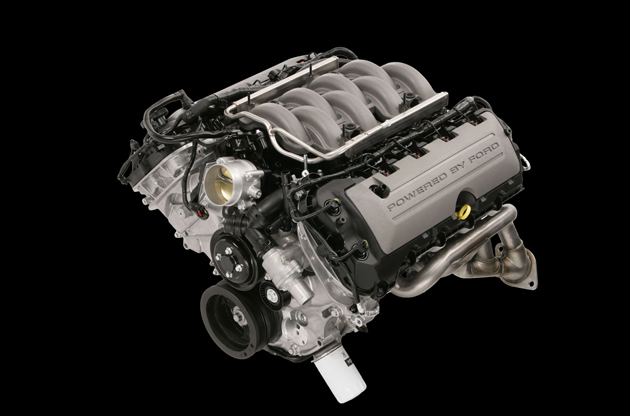
According to chief engineer Mike Harrison, VP of global product development Derrick Kuzak tasked him with developing a new engine for the Mustang just over two years ago, and in that time his team has gone from clean sheet to production. That makes this one of Ford's fastest engine development programs ever. The basic parameters were laid out as such: 5.0 liters of displacement and 400 horsepower. The end result is an engine with 92.2mm bore and a 92.7mm stroke. For the mathematically challenged, that works out to 4,952 cubic centimeters and now properly rounds to 5.0-liters while still equaling 302.2 cubic inches. As for the power requirement? Mission accomplished, with 412 hp at 6,500 rpm and 390 pound-feet at 4,000 rpm.
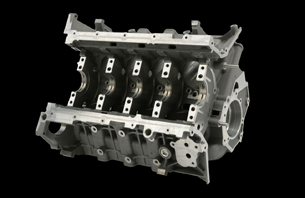
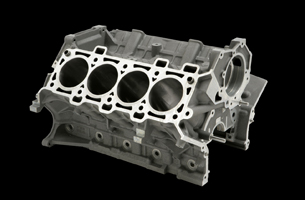
The new 5.0 also has a brand new aluminum cylinder block and heads designed to maximize performance while keeping weight down. Both have been carefully designed using both finite element analysis (FEA) and computational fluid dynamics (CFD) tools. The FEA tools have allowed the engineers to design in strength where it's needed while removing material where it's not. The result is a block that's heavily ribbed for rigidity and a deep crank-case that extends down to the bottom of the crankshaft. The 5.0 has four-bolt main bearing caps and the deep crank-case allows the side bolts to fit through the wall into caps that add extra rigidity and support. The configuration happens to be similar to that used on General Motors' LS9 and LSA engines in the ZR1 and CTS-V. Cast-iron cylinder liners, meanwhile, are pressed into the aluminum block to insure a good wearing surface.
The crankshaft is made of forged steel and is fully counter-weighted to aid smoothness. The connecting rods are forged powdered metal and the pistons are hyper-eutectic (translation: they contain a higher concentration of silicon, which helps reduce thermal expansion). As a result, the tolerances between the piston and bore can be tighter and allow for better sealing. Another change made to improve reliability and durability is cast-in coolant crossovers. In the past, a separate tube was inserted to provide a path for coolant to cross from one bank to the other, which added an extra assembly process as well as increasing the potential for leaks.
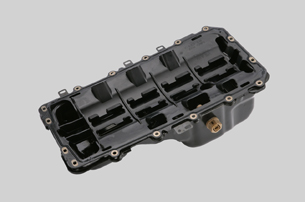
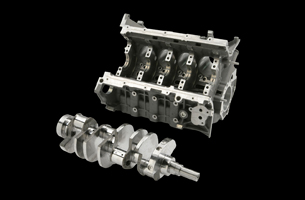
Looking at the top of the 5.0's bare block, one thing that's immediately apparent is the size of the oil drain back ports. These help ensure that oil gets back down to the sump as good lubrication is critical to a high performance engine. The 5.0 gets a heavily baffled sump with an eight-quart capacity and the baffles help to ensure there is always oil in the vicinity of the pick up no matter how aggressively the car is being driven. Harrison explained that in a car cornering at 1g of lateral acceleration with a 90-degree block, the forces on the oil in the outboard bank are equivalent to the lower bank if the the engine is rotated 90 degrees around the crank axis. In fact, this is exactly what Harrison's team did in the dyno lab to ensure that oil could flow back to the sump – they mounted the engine on its side. The 5.0 also gets oil jets at the base of each cylinder that spray oil on the underside of the pistons to help cool them.
As any good athlete will tell you, the key to performance is respiration – get the air in and the exhaust out. When it comes to airflow, the best approach is a straight shot. Anytime the flow has to change direction it slows down. Ideally you also want the largest possible orifice to deliver air with minimal restriction. One of the weaknesses of the prior 4.6-liter V8 was its alternator mounted up on top of the engine between the cylinder banks, right where you'd intuitively want a throttle body to be located. As such, the 4.6 used a two-barrel throttle body in order to clear the top of the alternator. On the new 5.0, the alternator has been moved down to the side of the block leaving the valley completely unencumbered for a large 80mm single-barrel throttle body.
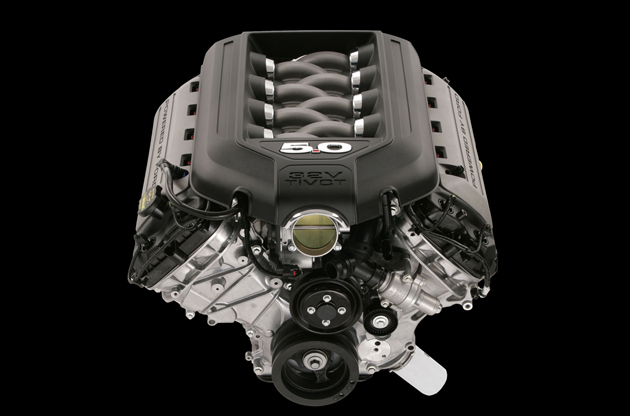
From the throttle body, the air flows into a new composite manifold, and like with many current engines, the use of a composite intake manifold has several advantages. It reduces the mass at the top end of the engine, which lowers center of gravity, and the internal passages are also smoother, thus lowering the flow restriction and aiding breathing. The top half of the 5.0's composite manifold is molded in gray to match the aluminum blocks -- a nice aesthetic addition considering the tubes are left exposed by the engine trim. Rather than cover the entire engine, Ford opted for what is essentially a frame for the very attractive intake tubes with a big 5.0 badge on the front.
Compared to both the 5.0 "Cammer" crate engine and the 5.4-liter GT500 engine, the new five-point-oh's cylinder heads have also been redesigned. Both the intake and exhaust camshafts have been shifted outboard relative to their previous positions. This made room to reconfigure the intake ports so that they now run virtually parallel to the intake valves, providing the air flow a nearly straight shot into the combustion chamber. The engineering team spent hundreds of hours experimenting with CFD models to optimize the flow of air and exhaust, which included designing the manifold, the combustion chamber and the exhaust.
Air flow and efficiency is further enhanced by twin independent variable cam timing. Like Ford's 2.5-liter four-cylinder engine and revised 3.0-liter V6 that were introduced in 2008, cam-torque actuation (CTA) is incorporated on the 5.0. The CTA system utilizes the energy that builds up inside the camshaft itself as the lobes ride up on the valve followers. The resistance of the valve causes twisting force to build up within the camshaft. As the peak of the lobe passes the valve, the force is released causing the camshaft to "spring" back. This energy is captured in a phasing mechanism mounted on the end of the camshaft that makes adjustments much faster and to a greater degree than traditional systems. The mechanism contains an electronically controlled spool valve to manage the flow of hydraulic fluid into a pair of chambers. Check valves maintain the oil pressure built up within those chambers and that pressure is used to adjust the relative angle of the camshaft adjusting the timing.
Even without using direct injection, Ford was still able to achieve an impressive 11:1 compression ratio while allowing the engine to still run on regular gas. According to Harrison, a lot of effort was expended on the engine management system. The adaptive spark control system keeps the engine running right on the knock sensor all the time, continuously adjusting the spark advance to avoid detonation regardless of the fuel used. The control system has a high bandwidth air-fuel control algorithm to make sure that it's both responsive and efficient. The 5.0 has also benefited from work done on the Fusion Hybrid by incorporating aggressive deceleration fuel shut-off. Whenever the throttle is released, fuel flow is shut off completely to improve efficiency.
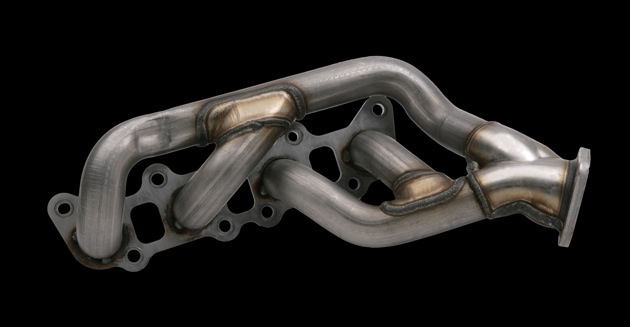
Once the fuel is burned, it's just as important to get the exhaust gases out of the engine as it is to get air in. With this in mind, the 5.0 has tubular stainless steel exhaust headers. The design of the headers features two secondary tubes that flow into two primary tubes, which then flow into a common collector. The tube lengths are tuned to ensure that there are no exhaust pulses pushing gases back into adjacent cylinders. Engineer Adam Christian developed the headers using a CFD program, but when the design was sent out to a local prototype shop for fabrication, the parts performed poorly on the dyno. After seeing the results, Christian requisitioned some tubing, took it home and fabricated a set of headers using his own tools. These performed perfectly on the engine and were used to correlate the model. The production units are being supplied to Ford by Benteler Automotive.
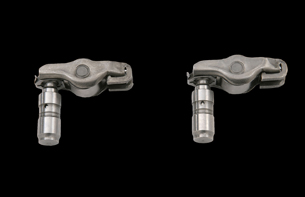
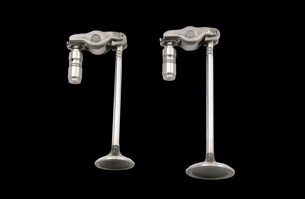
Keeping the cost down and improving reliability were also both important criteria in the new design. One of the interesting features is a compact roller follower. A compact assembly consisting of a hydraulic lash adjuster linked with a roller rocker arm is simply inserted into the bore adjacent to the valve stem. The same part is used for both the intake and exhaust valves and no adjustment is required during assembly. When the heads are bolted to the block, a three-layer metal gasket provides sealing between them.
Harrison claims the new 5.0 has best-in-class airflow compared to similar V8 engines. The result is a five-percent improvement in low end torque and two-percent better top end torque compared to the former crate engine. While torque peaks at 4,000 rpm, it's well above 300 pound-feet throughout most of the rpm range. The redline of the 5.0 has also been moved up an extra 500 rpm compared to the prior 4.6-liter to a full 7,000 rpm, and judging by the curves we were shown, it will probably be worth using all of them. Thanks in part to the higher compression, the engine is also more efficient than the 4.6-liter V8. In spite of producing 31 percent more power and 20 percent more torque than the old 4.6, the new engine achieves four-five percent better efficiency across its operating range. As such, the 2011 Mustang GT is expected to score at least 25 mpg on the highway from the EPA.
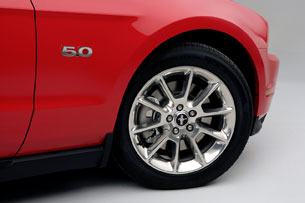
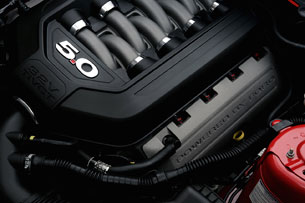
The 5.0 will be built at Ford's Essex engine plant in Windsor, Ontario starting early in 2010. The tighter tolerances, reduced friction and increased precision in manufacturing will help Ford increase the oil change interval on the new engine to 10,000 miles using conventional 5W20 oil. Fully dressed (minus the A/C compressor) and filled with oil, the new engine weighs in at 430 pounds. That's about the same as the outgoing 4.6 in spite of the extra valve train hardware. By comparison, a non-dry-sump GM LS3 used in the Camaro or Corvette weighs a bit over 400 pounds, which is not enough to make up the difference in overall vehicle weight between the Camaro and Mustang. The 2011 Mustang GT goes on sale in spring 2010, and based on the engine tech alone, we're itching for our chance behind the wheel.


Sign in to post
Please sign in to leave a comment.
Continue